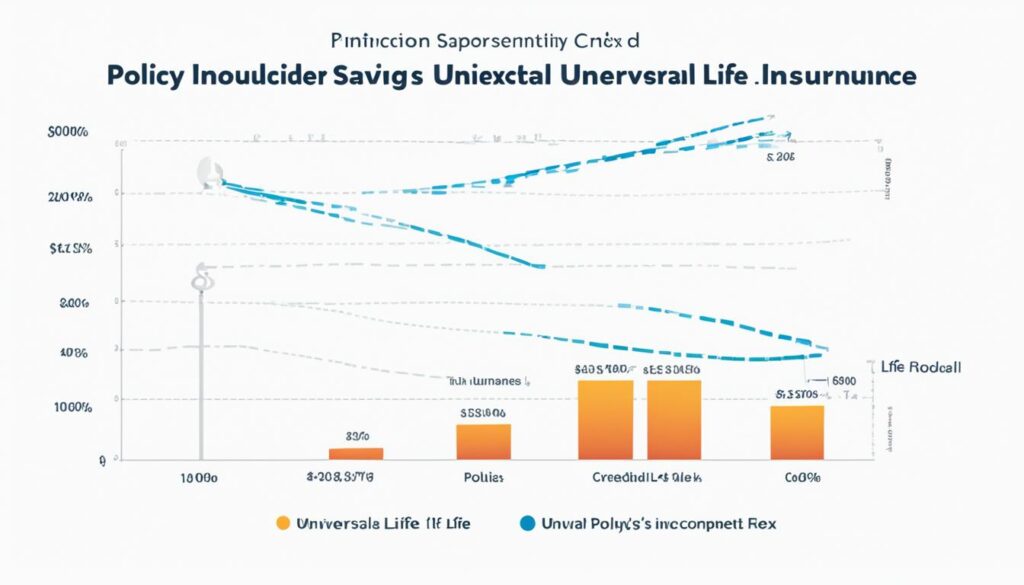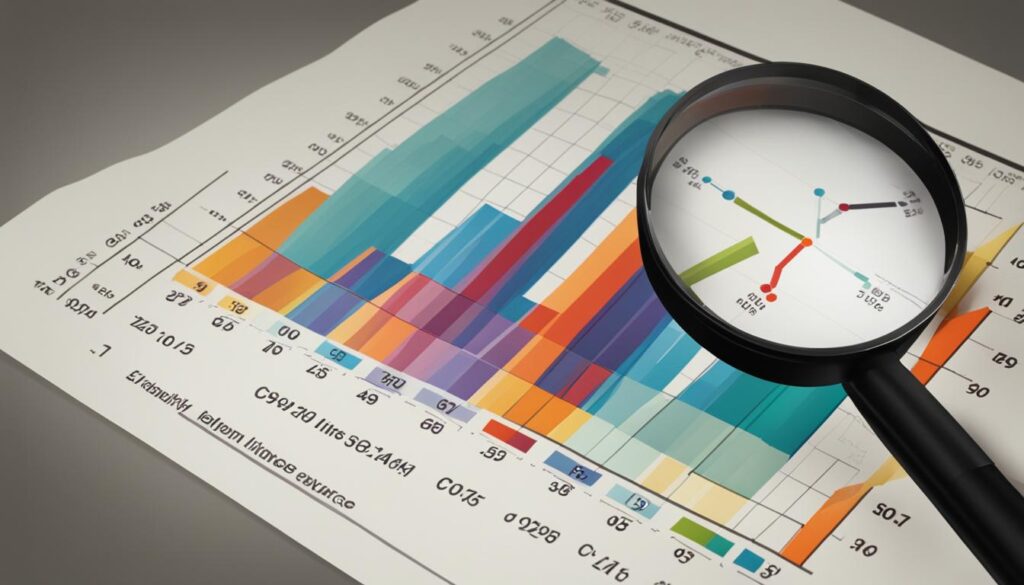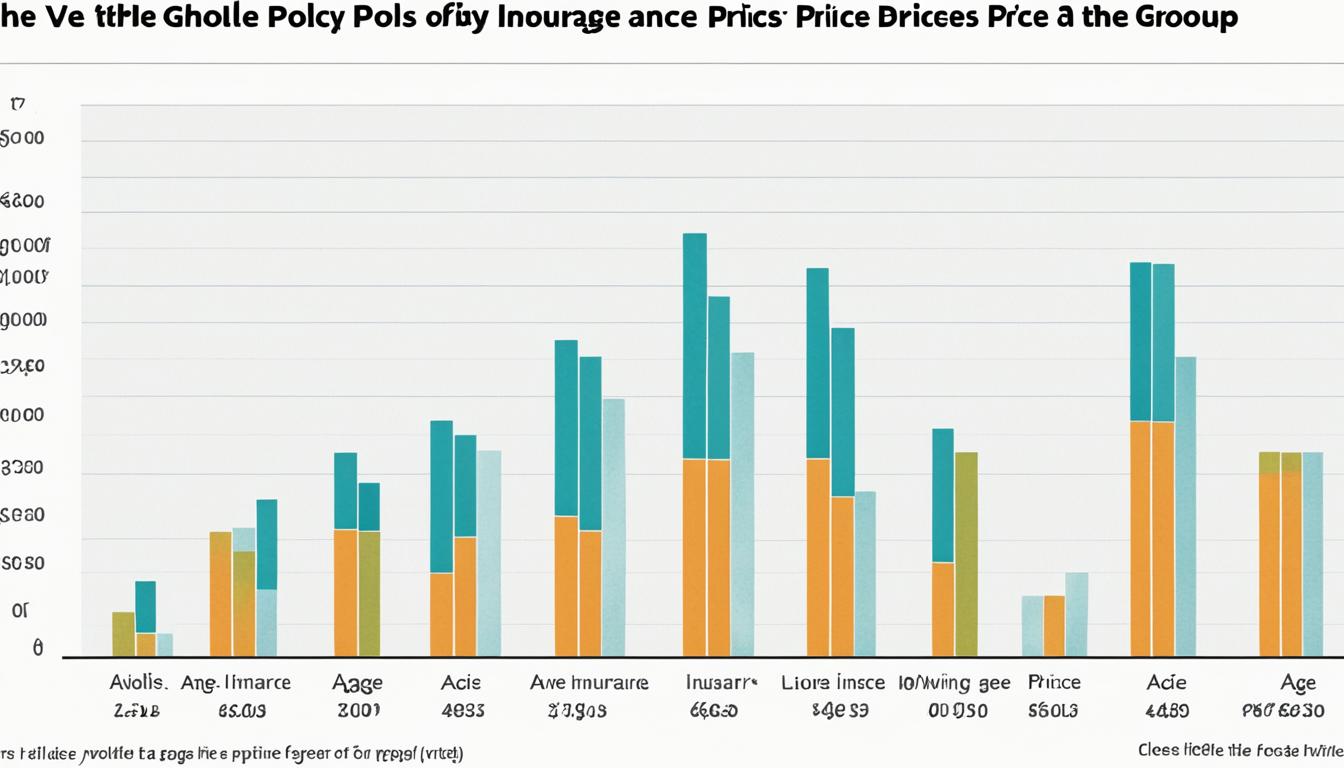Indexed universal life insurance cost (IUL) offers the flexibility to adjust premiums, death benefits, and cash values during the policy’s lifespan. With an IUL policy, the premiums you pay can earn interest and build a cash value tied to the performance of an index, such as the S&P 500. When determining the coverage amounts for IUL, factors like financial stability, dependents, and reasons for purchasing insurance should be considered.
Key Takeaways:
- Indexed universal life insurance (IUL) allows for flexibility in premium payments and death benefits.
- Premiums paid into an IUL policy can earn interest and create a cash value linked to the performance of an index.
- Factors such as financial stability and dependents should be considered when determining coverage amounts for IUL.
- IUL provides potential for higher returns compared to other life insurance policies, but there are also risks and fees associated with it.
- Choosing the right coverage amounts and insurance company is crucial when considering an indexed universal life insurance policy.
What is Indexed Universal Life Insurance (IUL)?
Indexed Universal Life Insurance (IUL) is a type of permanent life insurance coverage that provides policyholders with the flexibility to adjust premiums and death benefit amounts according to their needs. What sets IUL apart is the cash value component, which can grow based on the performance of a financial index, such as the S&P 500. This cash value accumulation differentiates IUL from other types of universal life policies.
With an IUL policy, policyholders have the potential to earn returns based on the performance of the chosen financial index. The policy’s cash value can increase over time, offering potential savings and additional benefits.
IUL policies may also offer fixed interest rate options in addition to indexed accounts. This means policyholders have the opportunity to allocate a portion of their premium payments into accounts that earn a fixed rate of interest, providing stability and diversification to their policy’s cash value growth.
Overall, Indexed Universal Life Insurance provides policyholders with the ability to tailor their coverage to their specific needs, while potentially benefiting from market-driven returns and the growth of their cash value.
How Indexed Universal Life Insurance Works
Indexed universal life insurance (IUL) operates similarly to traditional universal life insurance policies. Policyholders pay premiums in exchange for lifelong coverage and the accumulation of a cash value component. However, IUL policies offer additional flexibility and potential growth based on market performance through indexed accounts.
The cash value of an IUL policy can grow through two different methods:
- Fixed Interest Rates: Some IUL policies offer a fixed interest rate option for the cash value component. This means that the cash value will accumulate at a predetermined rate set by the insurance company.
- Indexed Accounts: The cash value can also earn interest based on the performance of indexed accounts tied to a financial index, such as the S&P 500. The interest credited to the cash value is determined by the participation rate, cap rate, floor rate, and the interest calculation methods used by the insurance company.
One of the key features of indexed universal life insurance is the ability to adjust premiums and death benefit amounts as needed. Policyholders can increase or decrease their premiums or death benefits to align with their changing financial circumstances. This flexibility sets IUL apart from other types of life insurance policies.
Participation Rate: The participation rate determines how much of the indexed account’s performance is credited to the cash value. For example, if the participation rate is 80%, the cash value will earn 80% of the indexed account’s growth.
Cap Rate: The cap rate places a limit on the maximum interest that can be credited to the cash value in a given period, even if the indexed account’s performance exceeds that rate.
Floor Rate: The floor rate ensures that the cash value will not earn less than a certain minimum interest rate, even if the indexed account’s performance is negative or below the floor rate.
Interest Calculation Methods
The interest calculation methods used by insurance companies to determine the cash value growth can vary. Common methods include:
- Annual Point-to-Point: This method compares the value of the financial index at the beginning and end of a one-year period to calculate the interest credited to the cash value.
- Monthly Averaging: The interest is determined by averaging the value of the financial index over a 12-month period.
- Monthly Point-to-Point: Similar to the annual point-to-point method, but calculated on a monthly basis.
It’s important for individuals considering indexed universal life insurance to carefully review and understand the participation rates, cap rates, floor rates, and the interest calculation methods used by the insurance company. This information will help policyholders make informed decisions about their coverage and potential cash value growth.

Pros and Cons of Indexed Universal Life Insurance
Indexed universal life insurance (IUL) offers both advantages and disadvantages that individuals should consider when deciding whether it’s the right fit for their financial goals and needs.
Pros of Indexed Universal Life Insurance
- Flexibility: One of the key benefits of IUL is the ability to adjust premiums and death benefits according to changing financial circumstances.
- Stock Market-Driven Returns: IUL policies offer the potential for higher returns compared to traditional universal life insurance, as they are linked to the performance of indexed accounts tied to the stock market.
- Control: Policyholders have greater control over their IUL policies, allowing them to tailor the coverage and cash value accumulation to their specific needs and objectives.
Cons of Indexed Universal Life Insurance
- Risk: As IUL policies are tied to the stock market, there is a certain level of risk associated with how the market performs. During periods of market downturns, the cash value growth may be lower or even negative.
- Capped Returns: While IUL policies offer the opportunity for higher returns through indexed accounts, these returns are often capped, meaning there is a limit on the maximum growth the policy can achieve.
- Fees: IUL policies may come with various fees, including administrative fees, premium charges, and mortality charges. These fees can potentially reduce the overall returns and cash value accumulation of the policy.
- Active Policy Monitoring: Due to the market-driven nature of IUL policies, policyholders need to actively monitor their policies during periods of low returns to ensure the desired protection and cash value growth objectives are being met.
Understanding the pros and cons of indexed universal life insurance allows individuals to make an informed decision based on their risk tolerance, financial goals, and long-term objectives.
Pros and Cons of Indexed Universal Life Insurance
| Pros | Cons |
|---|---|
| Flexibility to adjust premiums and death benefits | Risk associated with market performance |
| Potential for higher returns through stock market-driven indexed accounts | Capped returns limiting maximum growth |
| Control over policy features and cash value accumulation | Fees that can reduce overall returns |
| Need for active policy monitoring during periods of low returns |
How to Choose an Indexed Universal Life Insurance Company
When it comes to selecting an indexed universal life insurance company, it’s crucial to make an informed decision. The right company can provide you with the coverage and financial security you need. Two reputable options in the industry are Prudential Insurance Company and Voya Financial. Let’s explore what factors you should consider when evaluating life insurance companies.
Financial Strength Ratings
One of the primary factors to consider is the financial strength of the insurance company. Look for ratings from independent rating agencies like Standard & Poor’s, Moody’s, and A.M. Best. These ratings reflect the company’s ability to meet its financial obligations and pay out claims. Opt for companies with top ratings to ensure stability and reliability.
Consumer Experience
Take the time to research and evaluate the overall consumer experience with the insurance company. Read customer reviews and testimonials to gauge customer satisfaction levels. Look for feedback regarding the company’s responsiveness, claims process, and customer service. A positive consumer experience indicates the company’s commitment to its policyholders.
Complaint Data
Examining complaint data can give you insights into the company’s track record. Check with regulatory authorities or consumer advocacy groups to see if the company has received any significant complaints or has a history of poor customer service. Minimize your risk by selecting an insurance company with a low complaint rate and a track record of resolving issues promptly and fairly.
By considering these factors, you can ensure you choose an indexed universal life insurance company that meets your needs and offers the financial security you expect.

| Insurance Company | Financial Strength Ratings | Consumer Experience | Complaint Data |
|---|---|---|---|
| Prudential Insurance Company | A++ (A.M. Best) | Positive reviews, excellent customer service | Low complaint rate, resolved issues promptly |
| Voya Financial | A+ (Standard & Poor’s) | High customer satisfaction, responsive | Few complaints, fair resolution of issues |
How to Obtain an Indexed Universal Life Insurance Quote
To obtain an indexed universal life insurance quote, individuals need to provide personal details and meet insurance company requirements. These details help insurers assess risk and determine appropriate premium rates. Here’s what you need to know:
Gather Personal Details:
When requesting an indexed universal life insurance quote, be prepared to provide the following personal information:
- Date of birth
- Gender
- Height and weight
- Smoking status
These details help insurance companies assess your risk profile, which affects the cost of coverage.
Insurance Company Requirements:
Insurance companies may have specific requirements for applicants looking to obtain an indexed universal life insurance quote. In addition to personal details, insurers may also ask about your:
- Health history
- Driving record
These factors provide insurers with a comprehensive understanding of your risk profile, helping them assess the pricing and terms for your policy.
Medical Exam:
For certain underwritten policies, insurance companies may require a medical exam to evaluate your health and determine risk. The medical exam typically includes:
- Blood and urine samples
The results of the medical exam help insurers gain insights into your overall health and may impact the final premium rates offered for your indexed universal life insurance policy.
Quoting Process:
Once you have provided the necessary personal details and completed any required medical exams, insurance companies will use this information to generate an indexed universal life insurance quote tailored to your specific circumstances. It’s important to provide accurate and truthful information to ensure an accurate quote.
Obtaining multiple quotes from different insurance companies allows you to compare pricing and coverage options, helping you make an informed decision.
Remember, the quoted premium rates are subject to change based on the underwriting process, so it’s important to review the final terms and conditions before making a decision.

Providing the necessary personal details and meeting insurance company requirements is essential for obtaining an accurate indexed universal life insurance quote. Be sure to provide accurate and truthful information to ensure an accurate assessment of risk and premium rates.
Factors to Consider When Choosing Coverage Amounts
When deciding on the coverage amounts for indexed universal life insurance, it’s essential to consider various factors to ensure adequate protection for yourself and your loved ones. The coverage amount should be carefully determined based on your financial stability, number of dependents, household income, mortgage, and other expenses. Here’s a breakdown of these key factors:
Financial Stability
Assess your financial stability, including your current assets, savings, and debts. Consider how much coverage is necessary to provide financial security for your dependents in the event of your passing. Your coverage amount should account for any outstanding debts, such as mortgages, loans, or credit card balances.
Dependents
Evaluate the number and needs of your dependents. If you have young children or other family members who rely on your income, you’ll want to ensure that the coverage amount is sufficient to support their financial needs, including education, healthcare, and daily living expenses.
Mortgage and Other Expenses
Take into account any mortgages or large expenses that would need to be covered if you were no longer around. Consider the cost of ongoing living expenses, such as utilities, groceries, transportation, and healthcare, to determine the appropriate coverage amount that can support your beneficiaries in maintaining their current lifestyle.
Beneficiaries
Identify your beneficiaries and their financial needs. Whether it’s your spouse, children, or other loved ones, consider their long-term financial goals and responsibilities. The coverage should provide them with the necessary resources to meet these goals and maintain their standard of living.
Also Read:- Best Universal Life Policies For Secure Futures
By carefully assessing these factors, you can determine the appropriate coverage amount for your indexed universal life insurance policy. It’s crucial to review and update your coverage periodically as your circumstances change to ensure that your loved ones are adequately protected. Remember, seeking professional advice from a licensed insurance agent or financial advisor can help you make informed decisions based on your unique situation.

Indexed Universal Life Insurance vs. Other Life Insurance Policies
Indexed universal life insurance (IUL) sets itself apart from other types of life insurance, namely whole life insurance and term life insurance. While each policy offers its own unique benefits and features, understanding the differences can help individuals make an informed decision about their life insurance coverage.
Whole Life Insurance
Whole life insurance provides a fixed death benefit and the potential for cash value accumulation over time. Premiums for whole life insurance are typically higher compared to other types of life insurance due to the lifelong coverage and cash value growth. The cash value portion of a whole life insurance policy grows at a predetermined rate, often through dividends or policy participation. This type of policy is considered permanent coverage, meaning it lasts throughout the policyholder’s lifetime.
Term Life Insurance
Term life insurance, on the other hand, offers coverage for a specific period, known as the policy term. This type of policy does not accumulate cash value. Term life insurance is often chosen to cover financial obligations that have an expiration date, such as a mortgage or children’s college tuition. Premiums for term life insurance are typically lower compared to whole life insurance, making it a more affordable option for many individuals.
Indexed Universal Life Insurance
Indexed universal life insurance combines the benefits of permanent coverage with the potential for cash value growth tied to market indexes. Unlike whole life insurance, the cash value growth in an IUL policy is based on the performance of a specific financial index, such as the S&P 500. Policyholders have the flexibility to adjust their premiums and death benefit amounts as needed. This type of policy offers the opportunity for higher returns compared to traditional whole life insurance, but also carries a level of risk associated with market performance.
Here is a comparison table highlighting the main differences between indexed universal life insurance, whole life insurance, and term life insurance:
| Insurance Policy | Main Features | Cash Value Growth | Flexibility | Premiums |
|---|---|---|---|---|
| Indexed Universal Life Insurance | Combines permanent coverage with potential cash value growth tied to market indexes | Grows based on the performance of a financial index | Adjustable premiums and death benefit amounts | Flexible premium payments |
| Whole Life Insurance | Offers permanent coverage and cash value accumulation | Grows at a predetermined rate, often through dividends or policy participation | Fixed death benefit and cash value accumulation | Higher premiums compared to other types of life insurance |
| Term Life Insurance | Provides coverage for a specific period (policy term) | Does not accumulate cash value | Coverage for a specified timeframe | Lower premiums compared to whole life insurance |
Indexed universal life insurance offers the potential for higher returns compared to whole life insurance and allows policyholders to adjust their premiums and death benefit amounts. Term life insurance, on the other hand, provides coverage for a specific period without cash value accumulation. Understanding the features and benefits of each type of life insurance policy can help individuals choose the coverage that best suits their needs.

Benefits and Drawbacks of Indexed Universal Life Insurance
Indexed universal life insurance (IUL) provides policyholders with a range of benefits, as well as some drawbacks to consider. Understanding these advantages and disadvantages can help individuals make informed decisions about whether IUL is the right option for their life insurance needs.
Benefits of IUL
- Higher return potential: One of the key benefits of IUL is the potential for higher returns compared to other types of life insurance policies. The cash value portion of an IUL policy is tied to the performance of a financial index, such as the S&P 500. If the index performs well, policyholders have the opportunity to earn higher returns on their investment.
- Flexibility: IUL offers flexibility in premium payments and death benefits. Policyholders can adjust the amount of their premiums and death benefits based on their changing financial circumstances, allowing them to tailor the policy to their specific needs.
- Tax-free gains: Another benefit of IUL is that the cash value growth is generally tax-free. Policyholders can enjoy the potential for investment gains without incurring immediate tax obligations.
- No impact on Social Security benefits: The cash value and death benefit of an IUL policy generally do not impact a policyholder’s eligibility for Social Security benefits. This can be advantageous for individuals who rely on Social Security as a significant portion of their retirement income.
Drawbacks of IUL
- Limits on returns: While IUL offers higher return potential, it is important to note that there may be limits on the amount of growth. Insurance companies often impose participation rates, cap rates, and floor rates, which can limit the amount of interest earned on the cash value portion of the policy.
- Unpredictable returns: The returns on an IUL policy are tied to the performance of a financial index, which can be unpredictable. Market fluctuations can impact the growth of the cash value, and there is no guaranteed minimum interest rate.
- Fees: Like any life insurance policy, IUL policies may come with fees, such as administration fees, cost of insurance charges, and riders. These fees can reduce the overall return on investment and should be carefully considered.
It is essential for individuals considering IUL to weigh these benefits and drawbacks and assess how they align with their financial goals and risk tolerance. Consulting with a qualified insurance professional can help determine if IUL is the right choice for their individual circumstances.
Conclusion
Indexed universal life insurance (IUL) can be a suitable option for individuals who are looking for flexible coverage and the potential for cash value growth. Compared to other life insurance policies, IUL offers the opportunity for higher returns. However, it’s important to understand that IUL also comes with certain risks and fees that should be carefully considered.
When considering an indexed universal life insurance policy, it is crucial to choose the right coverage amounts and insurance company. This decision can have a significant impact on your overall financial plan and protection. Therefore, it’s recommended to evaluate various factors such as financial stability, dependents, and expenses to determine the appropriate coverage amounts that meet your specific needs.
Additionally, selecting a reputable insurance company is essential. Look for companies with a strong financial strength rating and positive consumer experiences. Reputable providers like Prudential Insurance Company and Voya Financial are known for their expertise in indexed universal life insurance.
To make an informed decision, it’s always wise to consult with a licensed insurance professional who can guide you through the process and help you understand the intricacies of indexed universal life insurance. With proper research and consideration, you can gain the advantages of flexible coverage and the potential for cash value growth that IUL offers.
FAQs
Q: What is Indexed Universal Life Insurance (IUL)?
A: Indexed Universal Life Insurance (IUL) is a type of permanent life insurance that offers a cash value account tied to a specific equity index, such as the S&P 500.
Q: How is the cost of IUL insurance determined?
A: The cost of IUL insurance is determined by various factors including the insured’s age, health, gender, and the desired death benefit. Additionally, the premiums for IUL policies can fluctuate based on the performance of the equity index.
Q: What are the pros and cons of Indexed Universal Life Insurance?
A: The pros of IUL include potential for cash value accumulation, flexibility in premium payments, and tax-free withdrawals. The cons include the complexity of the product, potential for increased premiums, and limitations on the growth linked to the equity index.
Q: How does Indexed Universal Life Insurance compare to other types of permanent life insurance?
A: Indexed Universal Life Insurance offers the potential for cash value growth linked to the performance of an equity index, whereas other types such as whole life or variable universal life may have different investment options or guarantees.
Q: Can I open an IUL account with any insurance provider?
A: Not all insurance providers offer Indexed Universal Life policies. It’s important to compare different insurance providers to find the best IUL policy that suits your needs and goals.
Q: How is the cash value in an IUL policy calculated?
A: The cash value in an IUL policy is calculated using a formula that takes into account the growth linked to the chosen equity index, minus any fees or charges associated with the policy.
Q: Is Indexed Universal Life Insurance more expensive than term life insurance?
A: Yes, Indexed Universal Life Insurance is typically more expensive than term life insurance due to the cash value accumulation and investment components included in the policy.
Q: What role does the equity index play in an IUL policy?
A: The equity index, such as the S&P 500, influences the potential growth of the cash value in an IUL policy. However, it’s important to note that the cash value is subject to caps, floors, or participation rates set by the insurance company.
Q: Where can I get a free quote for IUL insurance?
A: You can obtain a free quote for Indexed Universal Life Insurance from various insurance providers. It’s recommended to compare quotes from multiple providers to find the most competitive policy for your needs.
Q: How does Indexed Universal Life Insurance combine life insurance coverage with investment?
A: Indexed Universal Life Insurance combines life insurance coverage with the potential to accumulate cash value based on the performance of the chosen equity index. This allows policyholders to benefit from both protection and potential investment growth.




